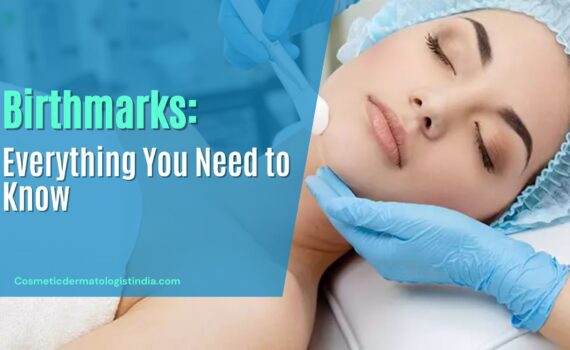
Birthmarks: Everything You Need to Know
‘It’s just a birthmark; ignore it!’ This statement you would have heard many times about the various marks on the body. Birthmarks come in different shapes and sizes, textures and placements, and are unique to each other. If you are a new parent, you might not be sure what to do with these birthmarks, or if you have a noticeable one on your body, it can be uncomfortable or embarrassing. Most people try to cover birthmarks with makeup or clothes.
The truth is that birthday marks are very common, and almost everybody has one of them, and some even have many. They are generally harmless; many fade away or are barely noticeable as the child grows up and do not need any treatments. But if the birthmarks are in large numbers or growing in size or clusters, then it is time to contact a dermatologist for a check-up and treatment.
What causes birthmarks?
Birthmarks are varied marks or discolorations on the body. They can be raised or flat, have regular or irregular corners and borders, and have different shapes and shades of colors, such as black, pink, blue, red, purple, tan, black, or brown. Researchers and doctors need to find out what causes these marks to appear on the body. There is still no guideline about if we can prevent them by doing something or not doing something during pregnancy. They cannot be attributed to genetics, as every child has a different birthmark. There are many different kinds of birthmarks, and there is no prediction about which birthmark will appear and where.
Different types of birthmarks
There are two kinds of birthmarks, namely pigmented and vascular birthmarks, which are qualified into further different types.
Pigmented birthmarks
They are colored birthmarks, and the pigment determines the color of the skin. They are caused when people have more pigment in one part of the skin. Pigmented birthmarks are of the following types.
- Moles: These are the most common types of birthmarks. They are also called congenital nevi as they are present at birth and last a lifetime. Another name for the moles is a hairy nevus. Babies of all races can develop a mole birthmark, but they are usually small moles. Large moles are rare. Moles are small and round spots, and they can be any color, such as black, brown, tan, or pink. Birthmark moles differ from those that happen during adulthood because of sun exposure. They are called hair nevus and have hair growing out of them. Moles going larger need to be checked out.
When to worry about them?
Mole birthmark is a cause of concern when they are found in large numbers at birth as it indicates excess pigment cells in the central nervous system. If not treated, these can cause pressure and seizures in the brain.
- Sebaceous nevi: These grow in the scalp and are caused because of the overgrowth of sebaceous glands. They are tan or range in color and are oval or comma-shaped. They do not fade over time, and there is no hair on the skin where these are present.
When to worry about them?
They are hardly likely to become cancerous, but regular check-ups are necessary. If the doctors notice changes in the birthmark, they might recommend surgical removal. This is usually common in adolescents because of the changing hormones. It also increases the chances of skin cancer developing.
- Café-au-lait spots: As glamorous as the name sounds, they are just named so after their coffee-colored appearance. On people with light skin, these look like milky coffee, and on dark-skinned people, they appear as dark coffee color. They are present at birth but often lighten as the years pass but don’t go away. They can also appear after the birth of the child.
When to worry about them?
If the child has more than six Café-au-lait spots or they are larger than a dime-sized coin, then it can be a cause of neurofibromatosis, and the dermatologist might ask for extra testing.
- Congenital dermal melanocytosis: This type of pigmented birthmark is grey or blue in color and is present on the backs and buttocks of infants. They are usually more prevalent in darker skin color, i.e., children of Asian, American Indian, African, and Southern European descent. They are also commonly called Mongolian spots, and they fade away as the child grows. Although they look like bruises, they are harmless and need specific attention. They are most common in Asian children and are not found in other races.
- Venous vascular malformation: They are red or purple in color and are formed because of enlarged or dilated veins under the skin. They can be seen on the skin during birth or late childhood and grow slowly. They don’t fade over time but don’t cause any need for worry.
Vascular birthmarks
These birthmarks are formed because of the clumping of blood vessels, which can be seen under the skin. They are usually red-colored and can be raised or flat. Some of them are small, and some can grow to cover large areas of skin. Vascular birthmarks can be present during the birth or develop a few weeks after the baby is born. They are of the following types.
- Salmon patches or flat stains or macular stains are salmon pink patches that appear under the skin. They are small, flat, pinkish red, and can appear in any part of the body. The skin with the birthmark is not thickened, and you can not feel the birthmark. The most common places these appear are the face, neck, back, and shoulders. Salmon patches on the back of the neck are known as stroke bites or Naevus flammeus, and they are permanent. When they appear in the center of the face, they are known as angel’s kisses. These fade away by 12 months of age.
- Hemangiomas: There are two types: superficial when they are on the skin’s surface and are also known as strawberry marks and deep Hemangiomas are deep in the layers of the skin and look blue in color because of the blood vessels under the skin. Both types of Hemangiomas appear to grow quickly when the child is born and disappear on their own in a few years (when the child reaches the age of 5-10 years). In addition, there is one more kind called compound Hemangiomas that affects both layers of the skin. They are usually found on the head or neck.
When to worry about them?
When they are large or leave behind an abnormal skin texture or rippled skin, red-pigmented skin, sometimes they can cause a problem because of their raised surface and interfere with feeding, breathing, cause problems in breathing or other body functions. When strawberry Hemangiomas are present at a body opening or body fold, they can open sores and cause blood or pus. Another indication that needs treatment is when the birthmarks grow in a beard pattern around the child’s mouth, chin or one side of the face. Children with such pattern hemangioma birthmarks on the skin also risk having them on organs or other places inside the body, making treatment a necessity.
- Port wine stains or Capillary malformation: These are large vascular birthmarks and look like a spill of red wine on the skin. They generally appear on the face, neck, arms, and legs. Initially flat pink or red, they can darken as time passes and become an unsightly deep red or purple. The skin under them can become thicker and hard, which becomes uncomfortable. They don’t go away on their own, and most people can manage to live with them.
When to worry about them?
Port wine stains can develop around the eyes and cause problems. In such cases, the doctor might recommend tests like MRI to ensure they don’t cause further issues such as Sturge-Weber syndrome, which can cause a high risk of glaucoma, seizures, etc.
Treatment for birthmarks?
The doctor will check the child for birthmarks when he or she is born and advise treatment if necessary. If the birthmark feels hard, has pain, causes discomfort on the skin, bleeds, feels warm to touch, itches, or looks infected, then it is time to visit the dermatologist immediately. Changes in the birthmarks’ number, size, texture, and color should also be observed carefully. Generally, pigmented birthmarks don’t need treatment, and vascular birthmarks often need treatment.
Birthmarks can be disfiguring for children and cause them to feel less about themselves. But most birthmarks can be treated easily with various treatment options. These include
- Oral medications such as
Propranolol for treatment of haemangioma. This can reduce the size and discolor the birthmark. This is also effective if it is located in the airway or near the eyes or mouth or is causing disruption in breathing or for just cosmetic reasons.
- Topical treatments such as
Timolol to apply on the birthmark. They are also mainly used to shrink and fade the hemangioma.
- Laser surgery or treatment: This is the most successful treatment for different types of birthmarks. Lasers reduce capillary malformations, strawberry hemangioma, brown birthmarks, café au lait spots, and blue-colored birthmarks (dermal melanocytosis). Vascular and pulsed dye lasers are most commonly used to remove the birthmark without damaging the skin. Laser is a fast and undamaging skin treatment and takes about 15 minutes to 1 hour to complete. They are usually done four weeks apart and in multiple sessions.
- Surgery for birthmarks is done when the other treatment options are not helpful, and the birthmark is causing severe impairment in normal bodily functions. Surgery is also used to remove congenital nevi birthmarks.
Birthmark removal cost
The cost of birthmark removal varies with many factors, such as the shape and size of the birthmark, the type of birthmark, and the location of the birthmark. Depending on all this, the surgeon will decide the kind of treatment needed to remove birthmarks. Birthmark removal cost also depends on the dermatologist’s expertise and the location of the clinic.
While most birthmarks do not require any surgical or medical intervention, most children and even adults can easily go through their life without being bothered. This is because birthmarks are unique, and there is no need to be embarrassed by them. However, if the child is self-conscious about the size or location of the birthmark, then it is better to take advice from a reputable dermatologist for the proper treatment.






